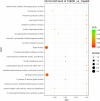The cwp66 Gene Affects Cell Adhesion, Stress Tolerance, and Antibiotic Resistance in Clostridioides difficile
- PMID: 35357205
- PMCID: PMC9045246
- DOI: 10.1128/spectrum.02704-21
The cwp66 Gene Affects Cell Adhesion, Stress Tolerance, and Antibiotic Resistance in Clostridioides difficile
Abstract
Clostridioides difficile is a Gram-positive, spore-forming anaerobic bacteria that is one of the leading causes of antibiotic-associated diarrhea. The cell wall protein 66 gene (cwp66) encodes a cell wall protein, which is the second major cell surface antigen of C. difficile. Although immunological approaches, such as antibodies and purified recombinant proteins, have been implemented to study the role of Cwp66 in cell adhesion, no deletion mutant of the cwp66 gene has yet been characterized. We constructed a cwp66 gene deletion mutant using Clustered Regularly Interspaced Short Palindromic Repeats Cpf1 (CRISPR-Cpf1) system. The phenotypic and transcriptomic changes of the Δcwp66 mutant compared with the wild-type (WT) strain were studied. The deletion of the cwp66 gene led to the decrease of cell adhesive capacity, cell motility, and stresses tolerance (to Triton X-100, acidic environment, and oxidative stress). Interestingly, the Δcwp66 mutant is more sensitive than the WT strain to clindamycin, ampicillin, and erythromycin but more resistant than the latter to vancomycin and metronidazole. Moreover, mannitol utilization capability in the Δcwp66 mutant was lost. Comparative transcriptomic analyses indicated that (i) 22.90-fold upregulation of cwpV gene and unable to express gpr gene were prominent in the Δcwp66 mutant; (ii) the cwp66 gene was involved in vancomycin resistance of C. difficile by influencing the expression of d-Alanine-d-Alanine ligase; and (iii) the mannose/fructose/sorbose IIC and IID components were upregulated in Δcwp66 mutant. The present work deepens our understanding of the contribution of the cwp66 gene to cell adhesion, stress tolerance, antibiotic resistance, and mannitol transportation of C. difficile. IMPORTANCE The cell wall protein 66 gene (cwp66) encodes a cell wall protein, which is the second major cell surface antigen of C. difficile. Although immunological approaches, such as antibodies and purified recombinant proteins, have been implemented to study the role of Cwp66 in cell adhesion, no deletion mutant of the cwp66 gene has yet been characterized. The current study provides direct evidence that the cwp66 gene serves as a major adhesion in C. difficile, and also suggested that deletion of the cwp66 gene led to the decrease of cell adhesive capacity, cell motility, and stresses tolerance (to Triton X-100, acidic environment, and oxidative stress). Interestingly, the antibiotic resistance and carbon source utilization profiles of the Δcwp66 mutant were significantly changed. These phenotypes were detrimental to the survival and pathogenesis of C. difficile in the human gut and may shed light on preventing C. difficile infection.
Keywords: CRISPR-Cpf1; Clostridioides difficile; cell wall protein 66 (Cwp66); phenotypic analysis; transcriptome analysis.
Conflict of interest statement
The authors declare no conflict of interest.
Figures








References
-
- Pantaléon V, Soavelomandroso AP, Bouttier S, Briandet R, Roxas B, Chu M, Collignon A, Janoir C, Vedantam G, Candela T. 2015. The Clostridium difficile protease Cwp84 modulates both biofilm formation and cell-surface properties. PLoS One 10:e0124971. doi:10.1371/journal.pone.0124971. - DOI - PMC - PubMed
-
- Wen X, Shen C, Xia J, Zhong L-L, Wu Z, Ahmed M-G-S, Long N, Ma F, Zhang G, Wu W, Luo J, Xia Y, Dai M, Zhang L, Liao K, Feng S, Chen C, Chen Y, Luo W, Tian G-B. 2022. Whole-genome sequencing reveals the high nosocomial transmission and antimicrobial resistance of Clostridioides difficile in a single center in China, a four-year retrospective study. Microbiol Spectr 10:e0132221. doi:10.1128/spectrum.01322-21. - DOI - PMC - PubMed
Publication types
MeSH terms
Substances
LinkOut - more resources
Full Text Sources
Other Literature Sources

